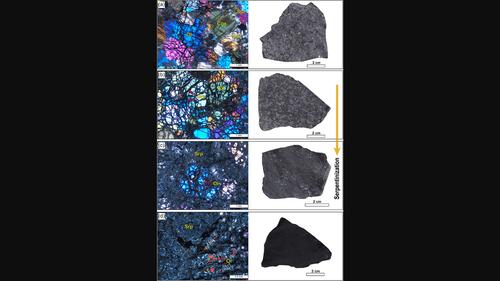Serpentinization and potential Ni‐Cr mineralization of the Andong ultramafic block in South Korea
IF 0.8
4区 地球科学
Q3 GEOLOGY
引用次数: 0
Abstract
Small‐ to medium‐sized serpentinized ultramafic blocks have been found in several locations in South Korea. Ultramafic‐hosted serpentinization, described as a major hydrothermal process that affects the lithospheric mantle, is known to play a key role in mass fluxes enhanced by multiple fluid–rock interactions that ultimately lead to the formation of hydrothermal mineralization and natural hydrogen production. In this study, we attempted to interpret the hydrothermal alteration and associated Ni‐Cr mineralization of the Andong serpentinized ultramafic block (ASUB). Based on the mineralogical and geochemical studies, the serpentinites and serpentinized ultramafic rocks of the ASUB are interpreted to be derived from mantle peridotite. It shows the dunite, lherzolite, and wehrlite compositions which are mainly composed of olivine and pyroxene. Hydrothermal alteration transformed the ultramafic rock into serpentinitic rock, resulting in changes in rock textures from the parent rock (plutonic texture) to moderately altered rock (pseudomorphic porphyritic texture) and strongly altered rock (pseudomorphic fine grained texture) with mineralogical changes. Serpentinization and Ni‐Cr mineralization do not show any relationship. Considering the reported crystallization age of the parental rock (222 Ma) and measured age (214–187 Ma) of the granites intruded into the ASUB, the source magma responsible for the final hydrothermal event including serpentinization is inferred to be the Late Triassic to Early Jurassic granitic pluton. The ASUB might have formed due to the ascent of a mantle plume along the extensional regime (i.e., rift) in the supra‐subduction zone (SSZ), rather than in ophiolite‐related mid‐oceanic ridges or abyssal environments, which are identified in many places. Ni‐Cr mineralization, with the close association of pentlandite, pyrrhotite, and Cr‐spinel, likely resulted from co‐precipitation and dissemination during the crystallization of the parent peridotitic magma derived from the mantle.

韩国安东超基性岩块的蛇绿岩化和潜在的镍铬矿化
在韩国的一些地方发现了中小型蛇绿岩化超基性岩块。众所周知,超基性岩蛇绿岩化是影响岩石圈地幔的主要热液过程,在多种流体-岩石相互作用增强的质量通量中发挥着关键作用,最终导致热液矿化的形成和天然氢的产生。在这项研究中,我们试图解释安东蛇绿岩化超基性岩块(ASUB)的热液蚀变和相关的镍铬矿化。根据矿物学和地球化学研究,ASUB的蛇纹岩和蛇纹超基性岩被解释为来自地幔橄榄岩。它显示出主要由橄榄石和辉石组成的云英岩、黑云母和辉绿岩成分。热液蚀变作用将超基性岩转化为蛇纹岩,导致岩石质地发生变化,从母岩(柱状质地)变为中度蚀变岩(假斑状质地)和强蚀变岩(假细粒质地),并伴有矿物学变化。蛇纹石化与镍铬矿化没有任何关系。考虑到报告的母岩结晶年龄(222 Ma)和侵入ASUB的花岗岩的测量年龄(214-187 Ma),推断造成包括蛇纹石化在内的最终热液事件的岩浆源是晚三叠世至早侏罗世花岗岩柱。ASUB可能是由于地幔羽流沿着超俯冲带(SSZ)的延伸机制(即裂谷)上升而形成的,而不是在与蛇绿岩有关的大洋中脊或深海环境中形成的,这在许多地方都有发现。镍铬矿化与闪长岩、黄铁矿和铬尖晶石密切相关,很可能是源自地幔的母质橄榄岩岩浆在结晶过程中共同沉淀和扩散的结果。
本文章由计算机程序翻译,如有差异,请以英文原文为准。
求助全文
约1分钟内获得全文
求助全文
来源期刊

Resource Geology
地学-地质学
CiteScore
2.30
自引率
14.30%
发文量
18
审稿时长
12 months
期刊介绍:
Resource Geology is an international journal focusing on economic geology, geochemistry and environmental geology. Its purpose is to contribute to the promotion of earth sciences related to metallic and non-metallic mineral deposits mainly in Asia, Oceania and the Circum-Pacific region, although other parts of the world are also considered.
Launched in 1998 by the Society for Resource Geology, the journal is published quarterly in English, making it more accessible to the international geological community. The journal publishes high quality papers of interest to those engaged in research and exploration of mineral deposits.
 求助内容:
求助内容: 应助结果提醒方式:
应助结果提醒方式:


